Deakin University: MPM712 Managing Innovation Case Study Report
VerifiedAdded on 2023/06/09
|30
|6433
|315
Report
AI Summary
This report presents a case study analysis of Nestle Australia's innovation management practices. It begins by outlining Nestle Australia's organizational context, including its market forces, competitive landscape, and technological environment, as well as describing its collaborations and knowledge resources. The report then examines the company's innovation capacity, focusing on its shared vision, leadership structure, key individuals, teamwork, and high-involvement innovation strategies. It also explores the creative environment fostered within Nestle Australia. The report further investigates the challenges and threats faced by Nestle Australia. The report concludes with a case study comparison and highlights the key factors that contribute to Nestle Australia's innovative capabilities. The report draws on information from various sources, including industry reports, academic research, and company publications, to provide a comprehensive understanding of Nestle Australia's approach to innovation.
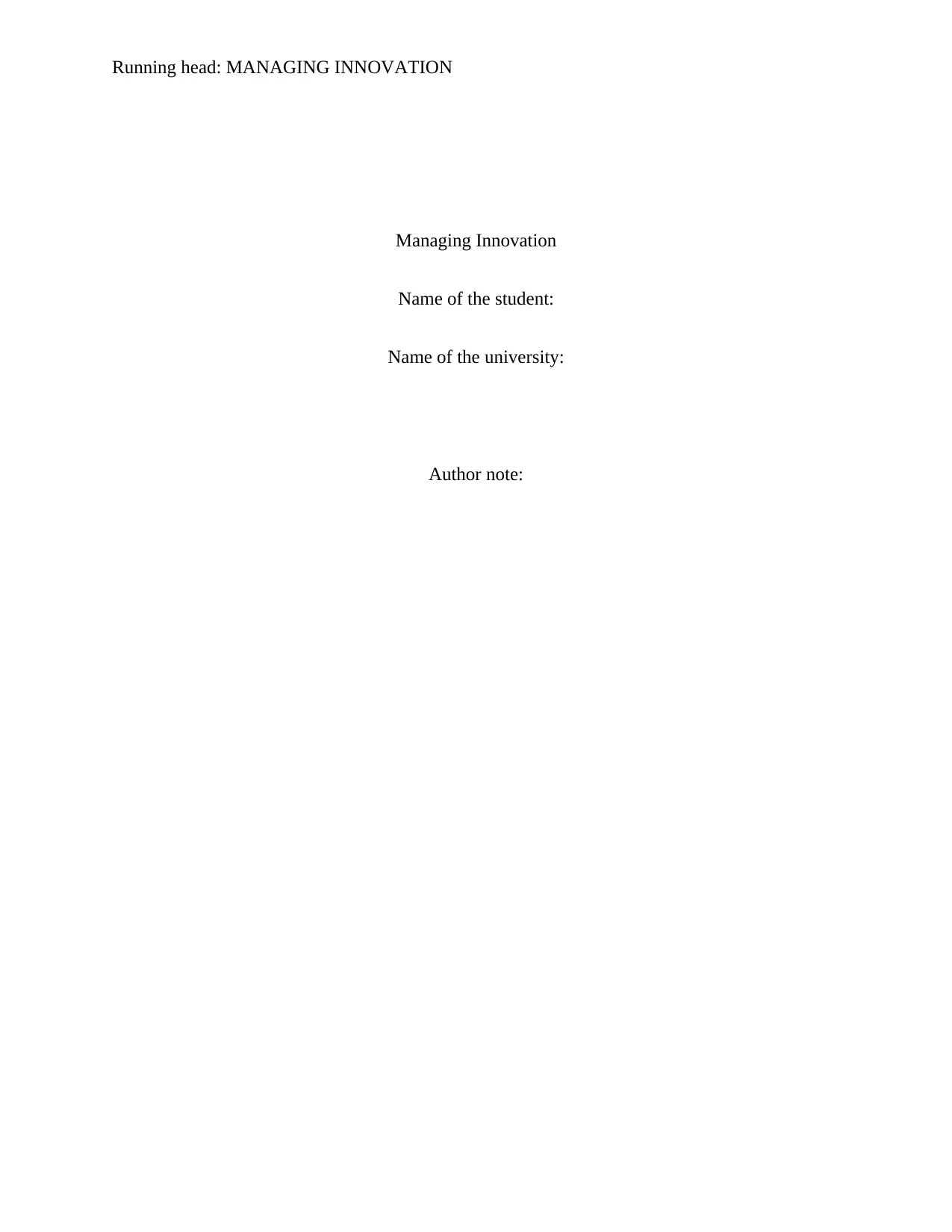
Running head: MANAGING INNOVATION
Managing Innovation
Name of the student:
Name of the university:
Author note:
Managing Innovation
Name of the student:
Name of the university:
Author note:
Paraphrase This Document
Need a fresh take? Get an instant paraphrase of this document with our AI Paraphraser
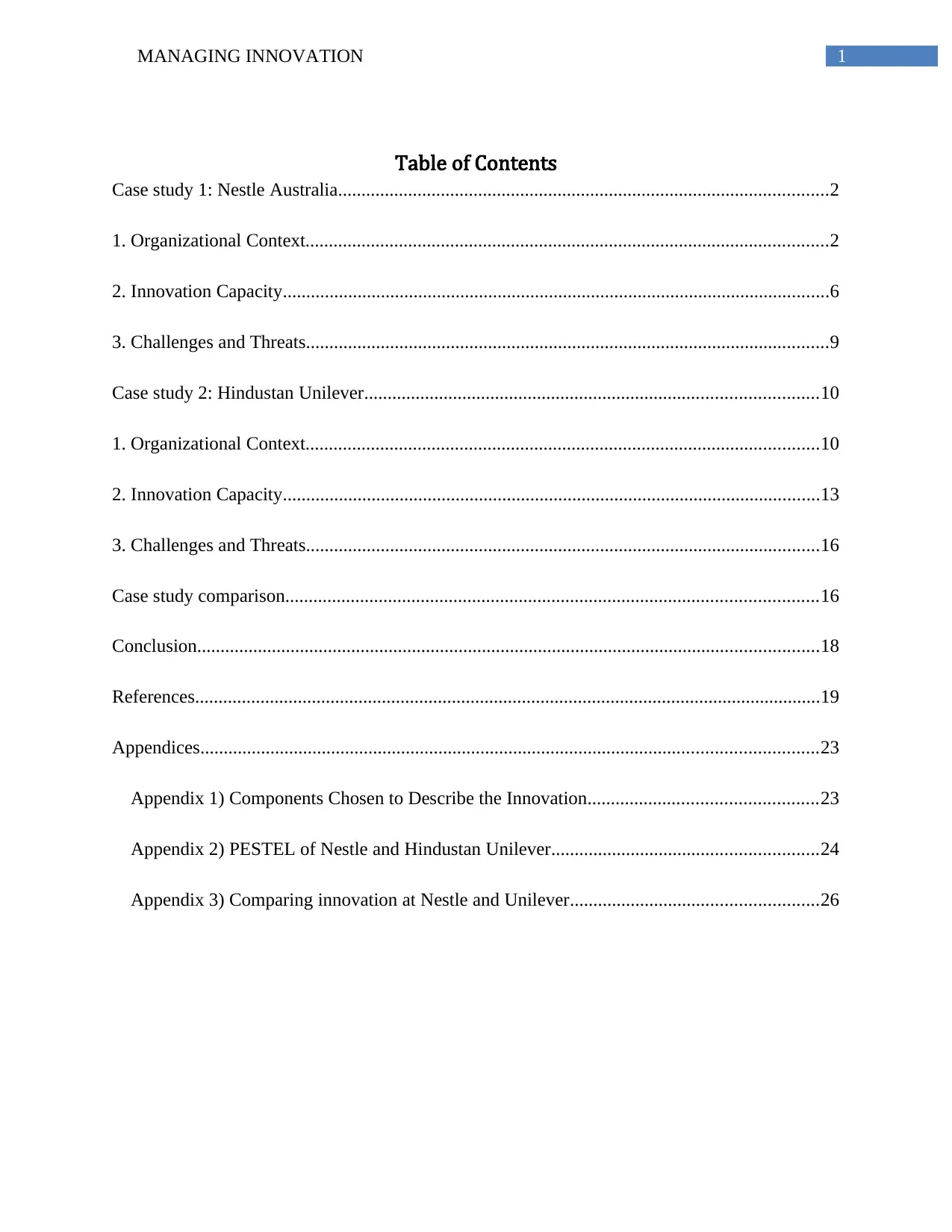
1MANAGING INNOVATION
Table of Contents
Case study 1: Nestle Australia.........................................................................................................2
1. Organizational Context................................................................................................................2
2. Innovation Capacity.....................................................................................................................6
3. Challenges and Threats................................................................................................................9
Case study 2: Hindustan Unilever.................................................................................................10
1. Organizational Context..............................................................................................................10
2. Innovation Capacity...................................................................................................................13
3. Challenges and Threats..............................................................................................................16
Case study comparison..................................................................................................................16
Conclusion.....................................................................................................................................18
References......................................................................................................................................19
Appendices....................................................................................................................................23
Appendix 1) Components Chosen to Describe the Innovation.................................................23
Appendix 2) PESTEL of Nestle and Hindustan Unilever.........................................................24
Appendix 3) Comparing innovation at Nestle and Unilever.....................................................26
Table of Contents
Case study 1: Nestle Australia.........................................................................................................2
1. Organizational Context................................................................................................................2
2. Innovation Capacity.....................................................................................................................6
3. Challenges and Threats................................................................................................................9
Case study 2: Hindustan Unilever.................................................................................................10
1. Organizational Context..............................................................................................................10
2. Innovation Capacity...................................................................................................................13
3. Challenges and Threats..............................................................................................................16
Case study comparison..................................................................................................................16
Conclusion.....................................................................................................................................18
References......................................................................................................................................19
Appendices....................................................................................................................................23
Appendix 1) Components Chosen to Describe the Innovation.................................................23
Appendix 2) PESTEL of Nestle and Hindustan Unilever.........................................................24
Appendix 3) Comparing innovation at Nestle and Unilever.....................................................26
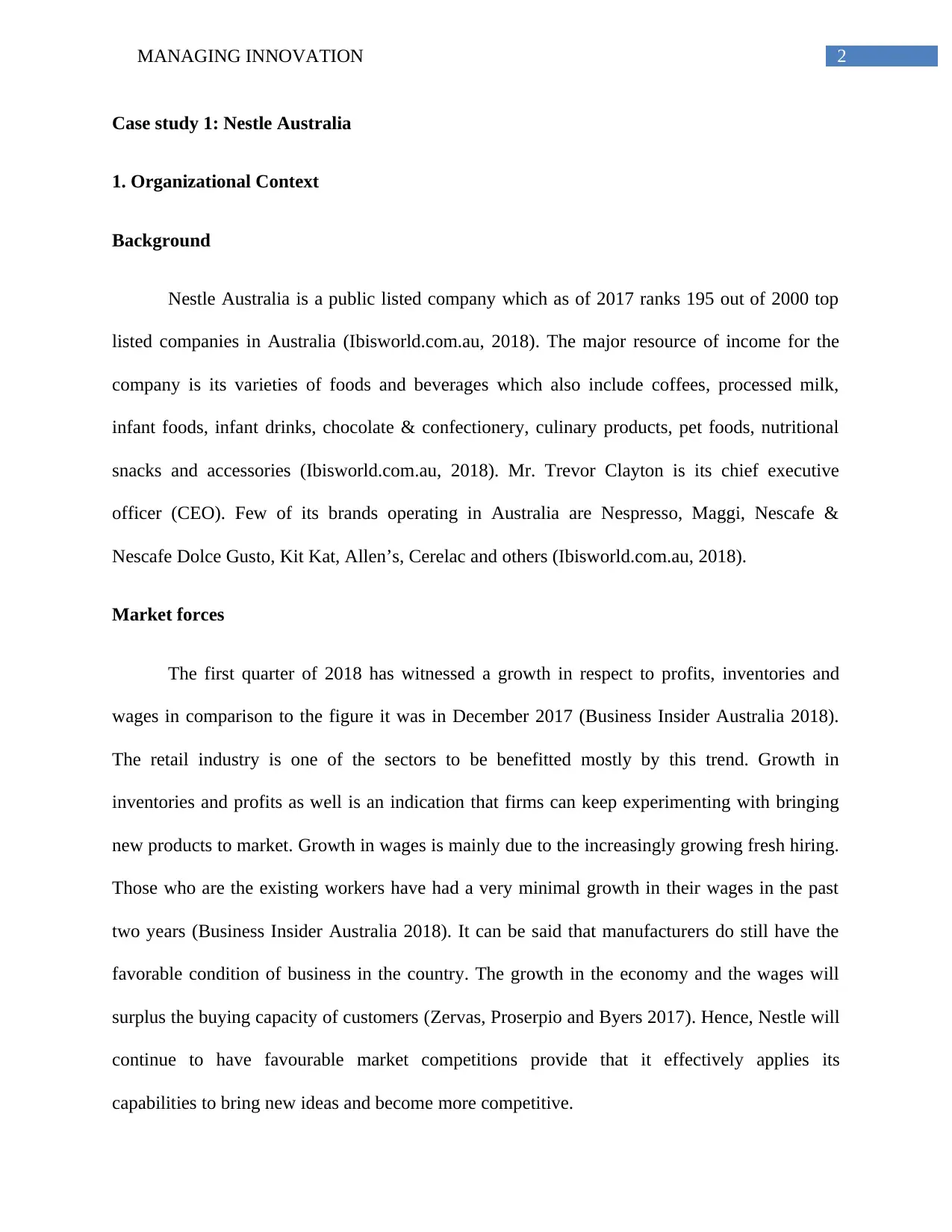
2MANAGING INNOVATION
Case study 1: Nestle Australia
1. Organizational Context
Background
Nestle Australia is a public listed company which as of 2017 ranks 195 out of 2000 top
listed companies in Australia (Ibisworld.com.au, 2018). The major resource of income for the
company is its varieties of foods and beverages which also include coffees, processed milk,
infant foods, infant drinks, chocolate & confectionery, culinary products, pet foods, nutritional
snacks and accessories (Ibisworld.com.au, 2018). Mr. Trevor Clayton is its chief executive
officer (CEO). Few of its brands operating in Australia are Nespresso, Maggi, Nescafe &
Nescafe Dolce Gusto, Kit Kat, Allen’s, Cerelac and others (Ibisworld.com.au, 2018).
Market forces
The first quarter of 2018 has witnessed a growth in respect to profits, inventories and
wages in comparison to the figure it was in December 2017 (Business Insider Australia 2018).
The retail industry is one of the sectors to be benefitted mostly by this trend. Growth in
inventories and profits as well is an indication that firms can keep experimenting with bringing
new products to market. Growth in wages is mainly due to the increasingly growing fresh hiring.
Those who are the existing workers have had a very minimal growth in their wages in the past
two years (Business Insider Australia 2018). It can be said that manufacturers do still have the
favorable condition of business in the country. The growth in the economy and the wages will
surplus the buying capacity of customers (Zervas, Proserpio and Byers 2017). Hence, Nestle will
continue to have favourable market competitions provide that it effectively applies its
capabilities to bring new ideas and become more competitive.
Case study 1: Nestle Australia
1. Organizational Context
Background
Nestle Australia is a public listed company which as of 2017 ranks 195 out of 2000 top
listed companies in Australia (Ibisworld.com.au, 2018). The major resource of income for the
company is its varieties of foods and beverages which also include coffees, processed milk,
infant foods, infant drinks, chocolate & confectionery, culinary products, pet foods, nutritional
snacks and accessories (Ibisworld.com.au, 2018). Mr. Trevor Clayton is its chief executive
officer (CEO). Few of its brands operating in Australia are Nespresso, Maggi, Nescafe &
Nescafe Dolce Gusto, Kit Kat, Allen’s, Cerelac and others (Ibisworld.com.au, 2018).
Market forces
The first quarter of 2018 has witnessed a growth in respect to profits, inventories and
wages in comparison to the figure it was in December 2017 (Business Insider Australia 2018).
The retail industry is one of the sectors to be benefitted mostly by this trend. Growth in
inventories and profits as well is an indication that firms can keep experimenting with bringing
new products to market. Growth in wages is mainly due to the increasingly growing fresh hiring.
Those who are the existing workers have had a very minimal growth in their wages in the past
two years (Business Insider Australia 2018). It can be said that manufacturers do still have the
favorable condition of business in the country. The growth in the economy and the wages will
surplus the buying capacity of customers (Zervas, Proserpio and Byers 2017). Hence, Nestle will
continue to have favourable market competitions provide that it effectively applies its
capabilities to bring new ideas and become more competitive.
⊘ This is a preview!⊘
Do you want full access?
Subscribe today to unlock all pages.

Trusted by 1+ million students worldwide

3MANAGING INNOVATION
Competitive forces
Nestlé’s Kit Kat faces stiff competition from Cadbury, Mars Bar, Snickers and Bounty.
However, it has to impose a strong fight to Cadbury in order to attain the top position in the list
of top chocolate manufacturers in Australia (Delforce, Dickson and Hogan 2015). The Australian
infant formula is growing in the Chinese market. Bellamy’s Organic in particular has had the
maximum benefits of the incrementing demands. The high-quality food and effective formulas
have worked for Australia (The Sydney Morning Herald 2018). There are opportunities;
however, Nestle must learn from the mistakes and the others like Bellamy doing exceptionally
well. The task does not look impossible indeed as Nestle has already been voted by Access to
Nutrition Index (ATNI) as the world’s biggest company to have the best nutrition policies,
delivery of appropriate & affordable products, product formulation and positive impact on
consumer behavior (Buchler, Smith and Lawrence 2014).
New technology
The fourth industrial revolution is there and expected to bring a lot more in terms of
advancement in manufacturing technologies. An Industry 4.0 is a new manufacturing era where
physical things in connection with the internet over the IoT platform will produce large-scale
data. Manufacturing in this way is expected to produce big data which will impact the product
relevancy (Lee, Kao and Yang 2014). Hence, this will eventually impact the customer
satisfaction level. However, it is extremely challenging to access every single data in real time.
In addition, managerial skills can be tested for addressing to the change. The managerial skills
needed to support the automation process are still unknown (Almada-Lobo 2016). In the likewise
manner, Nestle is into the similar kind of situation. Firms those are equipped with the skills to
Competitive forces
Nestlé’s Kit Kat faces stiff competition from Cadbury, Mars Bar, Snickers and Bounty.
However, it has to impose a strong fight to Cadbury in order to attain the top position in the list
of top chocolate manufacturers in Australia (Delforce, Dickson and Hogan 2015). The Australian
infant formula is growing in the Chinese market. Bellamy’s Organic in particular has had the
maximum benefits of the incrementing demands. The high-quality food and effective formulas
have worked for Australia (The Sydney Morning Herald 2018). There are opportunities;
however, Nestle must learn from the mistakes and the others like Bellamy doing exceptionally
well. The task does not look impossible indeed as Nestle has already been voted by Access to
Nutrition Index (ATNI) as the world’s biggest company to have the best nutrition policies,
delivery of appropriate & affordable products, product formulation and positive impact on
consumer behavior (Buchler, Smith and Lawrence 2014).
New technology
The fourth industrial revolution is there and expected to bring a lot more in terms of
advancement in manufacturing technologies. An Industry 4.0 is a new manufacturing era where
physical things in connection with the internet over the IoT platform will produce large-scale
data. Manufacturing in this way is expected to produce big data which will impact the product
relevancy (Lee, Kao and Yang 2014). Hence, this will eventually impact the customer
satisfaction level. However, it is extremely challenging to access every single data in real time.
In addition, managerial skills can be tested for addressing to the change. The managerial skills
needed to support the automation process are still unknown (Almada-Lobo 2016). In the likewise
manner, Nestle is into the similar kind of situation. Firms those are equipped with the skills to
Paraphrase This Document
Need a fresh take? Get an instant paraphrase of this document with our AI Paraphraser
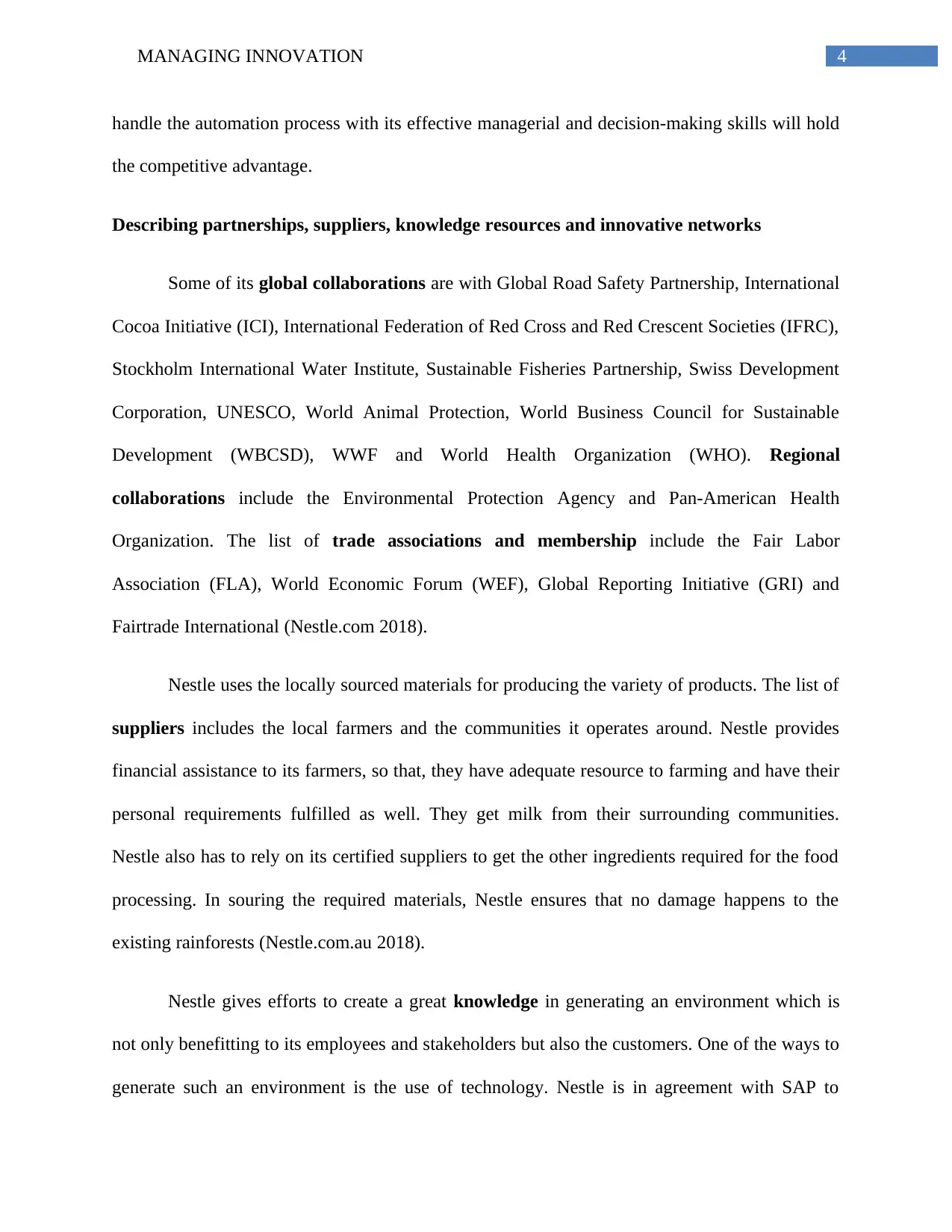
4MANAGING INNOVATION
handle the automation process with its effective managerial and decision-making skills will hold
the competitive advantage.
Describing partnerships, suppliers, knowledge resources and innovative networks
Some of its global collaborations are with Global Road Safety Partnership, International
Cocoa Initiative (ICI), International Federation of Red Cross and Red Crescent Societies (IFRC),
Stockholm International Water Institute, Sustainable Fisheries Partnership, Swiss Development
Corporation, UNESCO, World Animal Protection, World Business Council for Sustainable
Development (WBCSD), WWF and World Health Organization (WHO). Regional
collaborations include the Environmental Protection Agency and Pan-American Health
Organization. The list of trade associations and membership include the Fair Labor
Association (FLA), World Economic Forum (WEF), Global Reporting Initiative (GRI) and
Fairtrade International (Nestle.com 2018).
Nestle uses the locally sourced materials for producing the variety of products. The list of
suppliers includes the local farmers and the communities it operates around. Nestle provides
financial assistance to its farmers, so that, they have adequate resource to farming and have their
personal requirements fulfilled as well. They get milk from their surrounding communities.
Nestle also has to rely on its certified suppliers to get the other ingredients required for the food
processing. In souring the required materials, Nestle ensures that no damage happens to the
existing rainforests (Nestle.com.au 2018).
Nestle gives efforts to create a great knowledge in generating an environment which is
not only benefitting to its employees and stakeholders but also the customers. One of the ways to
generate such an environment is the use of technology. Nestle is in agreement with SAP to
handle the automation process with its effective managerial and decision-making skills will hold
the competitive advantage.
Describing partnerships, suppliers, knowledge resources and innovative networks
Some of its global collaborations are with Global Road Safety Partnership, International
Cocoa Initiative (ICI), International Federation of Red Cross and Red Crescent Societies (IFRC),
Stockholm International Water Institute, Sustainable Fisheries Partnership, Swiss Development
Corporation, UNESCO, World Animal Protection, World Business Council for Sustainable
Development (WBCSD), WWF and World Health Organization (WHO). Regional
collaborations include the Environmental Protection Agency and Pan-American Health
Organization. The list of trade associations and membership include the Fair Labor
Association (FLA), World Economic Forum (WEF), Global Reporting Initiative (GRI) and
Fairtrade International (Nestle.com 2018).
Nestle uses the locally sourced materials for producing the variety of products. The list of
suppliers includes the local farmers and the communities it operates around. Nestle provides
financial assistance to its farmers, so that, they have adequate resource to farming and have their
personal requirements fulfilled as well. They get milk from their surrounding communities.
Nestle also has to rely on its certified suppliers to get the other ingredients required for the food
processing. In souring the required materials, Nestle ensures that no damage happens to the
existing rainforests (Nestle.com.au 2018).
Nestle gives efforts to create a great knowledge in generating an environment which is
not only benefitting to its employees and stakeholders but also the customers. One of the ways to
generate such an environment is the use of technology. Nestle is in agreement with SAP to
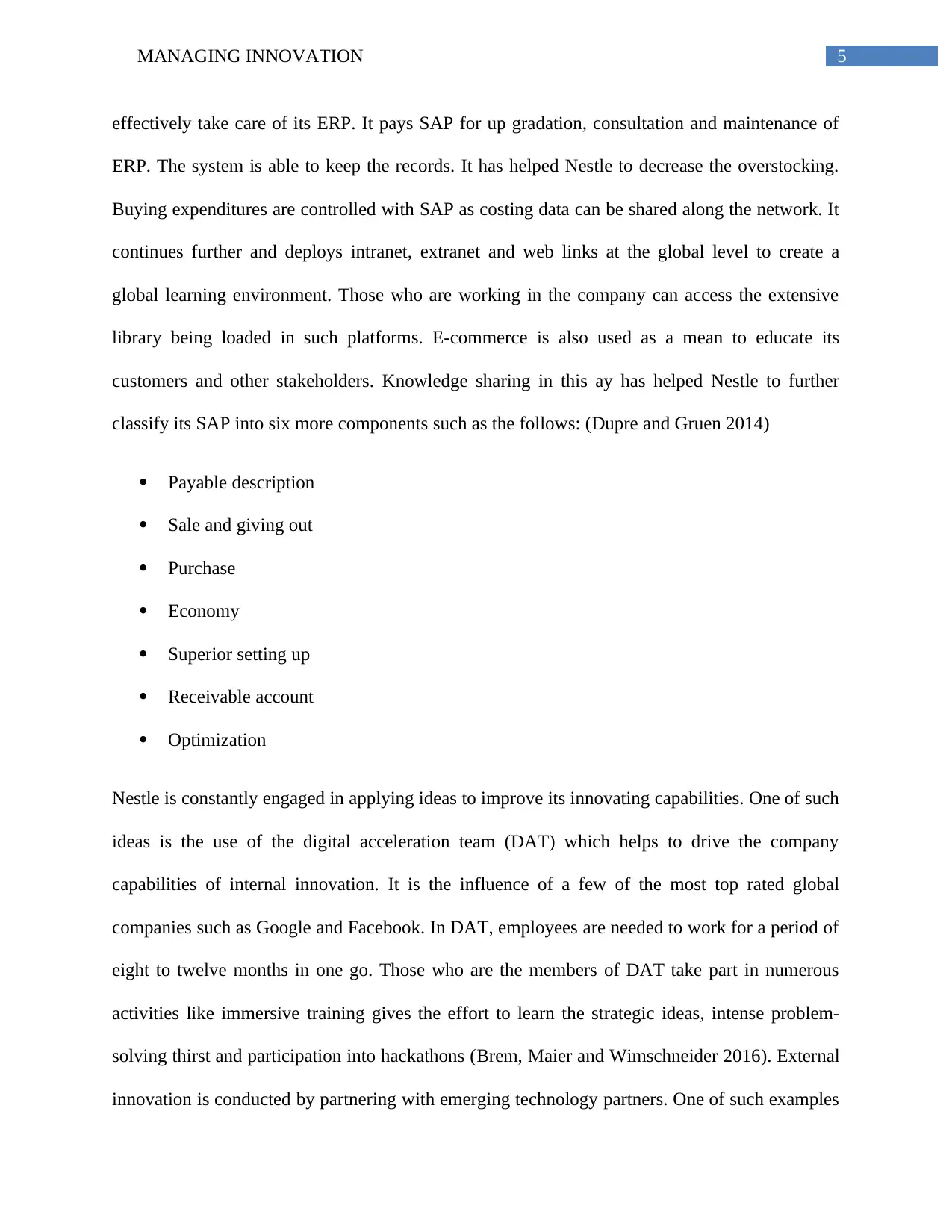
5MANAGING INNOVATION
effectively take care of its ERP. It pays SAP for up gradation, consultation and maintenance of
ERP. The system is able to keep the records. It has helped Nestle to decrease the overstocking.
Buying expenditures are controlled with SAP as costing data can be shared along the network. It
continues further and deploys intranet, extranet and web links at the global level to create a
global learning environment. Those who are working in the company can access the extensive
library being loaded in such platforms. E-commerce is also used as a mean to educate its
customers and other stakeholders. Knowledge sharing in this ay has helped Nestle to further
classify its SAP into six more components such as the follows: (Dupre and Gruen 2014)
Payable description
Sale and giving out
Purchase
Economy
Superior setting up
Receivable account
Optimization
Nestle is constantly engaged in applying ideas to improve its innovating capabilities. One of such
ideas is the use of the digital acceleration team (DAT) which helps to drive the company
capabilities of internal innovation. It is the influence of a few of the most top rated global
companies such as Google and Facebook. In DAT, employees are needed to work for a period of
eight to twelve months in one go. Those who are the members of DAT take part in numerous
activities like immersive training gives the effort to learn the strategic ideas, intense problem-
solving thirst and participation into hackathons (Brem, Maier and Wimschneider 2016). External
innovation is conducted by partnering with emerging technology partners. One of such examples
effectively take care of its ERP. It pays SAP for up gradation, consultation and maintenance of
ERP. The system is able to keep the records. It has helped Nestle to decrease the overstocking.
Buying expenditures are controlled with SAP as costing data can be shared along the network. It
continues further and deploys intranet, extranet and web links at the global level to create a
global learning environment. Those who are working in the company can access the extensive
library being loaded in such platforms. E-commerce is also used as a mean to educate its
customers and other stakeholders. Knowledge sharing in this ay has helped Nestle to further
classify its SAP into six more components such as the follows: (Dupre and Gruen 2014)
Payable description
Sale and giving out
Purchase
Economy
Superior setting up
Receivable account
Optimization
Nestle is constantly engaged in applying ideas to improve its innovating capabilities. One of such
ideas is the use of the digital acceleration team (DAT) which helps to drive the company
capabilities of internal innovation. It is the influence of a few of the most top rated global
companies such as Google and Facebook. In DAT, employees are needed to work for a period of
eight to twelve months in one go. Those who are the members of DAT take part in numerous
activities like immersive training gives the effort to learn the strategic ideas, intense problem-
solving thirst and participation into hackathons (Brem, Maier and Wimschneider 2016). External
innovation is conducted by partnering with emerging technology partners. One of such examples
⊘ This is a preview!⊘
Do you want full access?
Subscribe today to unlock all pages.

Trusted by 1+ million students worldwide

6MANAGING INNOVATION
is its collaboration with Amazon and its technology ‘Alexa’. In needful times, Nestle also takes
up the help of external entrepreneurs to solve out a different issue (Espinoza-Orias, Cooper and
Lariani 2018).
2. Innovation Capacity
Shared vision, the desire to innovate and leadership
Nestle believes in doing well for the business and also for the community. It means that
the company is focussed on the areas which produce long-term values for both shareholders and
the community.
The desire to innovate gets evident in a fact that it operates into three layers of
innovation to use the emerging innovating trends and also have a competitive advantage. The
internal layer is supported by the DAT program where the members work for a stretched period
of 8 to 12 months on different activities to bring in the innovating ideas. Externally, they
innovate by collaborating with emerging technology partners and also by hiring the external
entrepreneurs (Espinoza-Orias, Cooper and Lariani 2018).
Nestle is an aligned and decentralized organization which work upon a few principles to
ensure an effective leadership and productive workforce as well. Some of the leadership features
at Nestle Australia are as follows: (Bauer 2014)
Decentralisation for optimally responding to the consumers’ needs in the governance of
company’s framework defined by its fundamental policies and operational efficiencies
Ensuring that all its collaborations are in the guidelines of its principles and policies
is its collaboration with Amazon and its technology ‘Alexa’. In needful times, Nestle also takes
up the help of external entrepreneurs to solve out a different issue (Espinoza-Orias, Cooper and
Lariani 2018).
2. Innovation Capacity
Shared vision, the desire to innovate and leadership
Nestle believes in doing well for the business and also for the community. It means that
the company is focussed on the areas which produce long-term values for both shareholders and
the community.
The desire to innovate gets evident in a fact that it operates into three layers of
innovation to use the emerging innovating trends and also have a competitive advantage. The
internal layer is supported by the DAT program where the members work for a stretched period
of 8 to 12 months on different activities to bring in the innovating ideas. Externally, they
innovate by collaborating with emerging technology partners and also by hiring the external
entrepreneurs (Espinoza-Orias, Cooper and Lariani 2018).
Nestle is an aligned and decentralized organization which work upon a few principles to
ensure an effective leadership and productive workforce as well. Some of the leadership features
at Nestle Australia are as follows: (Bauer 2014)
Decentralisation for optimally responding to the consumers’ needs in the governance of
company’s framework defined by its fundamental policies and operational efficiencies
Ensuring that all its collaborations are in the guidelines of its principles and policies
Paraphrase This Document
Need a fresh take? Get an instant paraphrase of this document with our AI Paraphraser
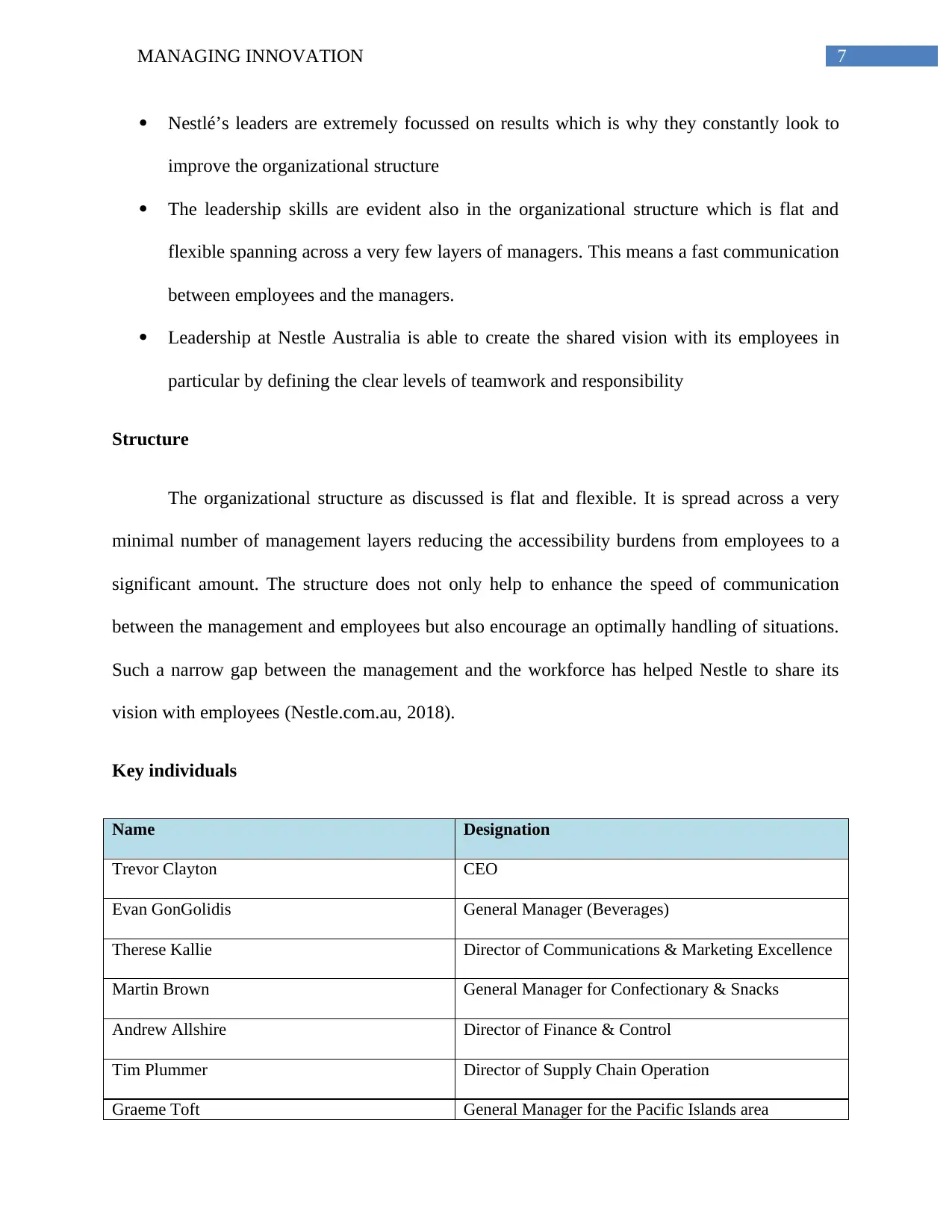
7MANAGING INNOVATION
Nestlé’s leaders are extremely focussed on results which is why they constantly look to
improve the organizational structure
The leadership skills are evident also in the organizational structure which is flat and
flexible spanning across a very few layers of managers. This means a fast communication
between employees and the managers.
Leadership at Nestle Australia is able to create the shared vision with its employees in
particular by defining the clear levels of teamwork and responsibility
Structure
The organizational structure as discussed is flat and flexible. It is spread across a very
minimal number of management layers reducing the accessibility burdens from employees to a
significant amount. The structure does not only help to enhance the speed of communication
between the management and employees but also encourage an optimally handling of situations.
Such a narrow gap between the management and the workforce has helped Nestle to share its
vision with employees (Nestle.com.au, 2018).
Key individuals
Name Designation
Trevor Clayton CEO
Evan GonGolidis General Manager (Beverages)
Therese Kallie Director of Communications & Marketing Excellence
Martin Brown General Manager for Confectionary & Snacks
Andrew Allshire Director of Finance & Control
Tim Plummer Director of Supply Chain Operation
Graeme Toft General Manager for the Pacific Islands area
Nestlé’s leaders are extremely focussed on results which is why they constantly look to
improve the organizational structure
The leadership skills are evident also in the organizational structure which is flat and
flexible spanning across a very few layers of managers. This means a fast communication
between employees and the managers.
Leadership at Nestle Australia is able to create the shared vision with its employees in
particular by defining the clear levels of teamwork and responsibility
Structure
The organizational structure as discussed is flat and flexible. It is spread across a very
minimal number of management layers reducing the accessibility burdens from employees to a
significant amount. The structure does not only help to enhance the speed of communication
between the management and employees but also encourage an optimally handling of situations.
Such a narrow gap between the management and the workforce has helped Nestle to share its
vision with employees (Nestle.com.au, 2018).
Key individuals
Name Designation
Trevor Clayton CEO
Evan GonGolidis General Manager (Beverages)
Therese Kallie Director of Communications & Marketing Excellence
Martin Brown General Manager for Confectionary & Snacks
Andrew Allshire Director of Finance & Control
Tim Plummer Director of Supply Chain Operation
Graeme Toft General Manager for the Pacific Islands area
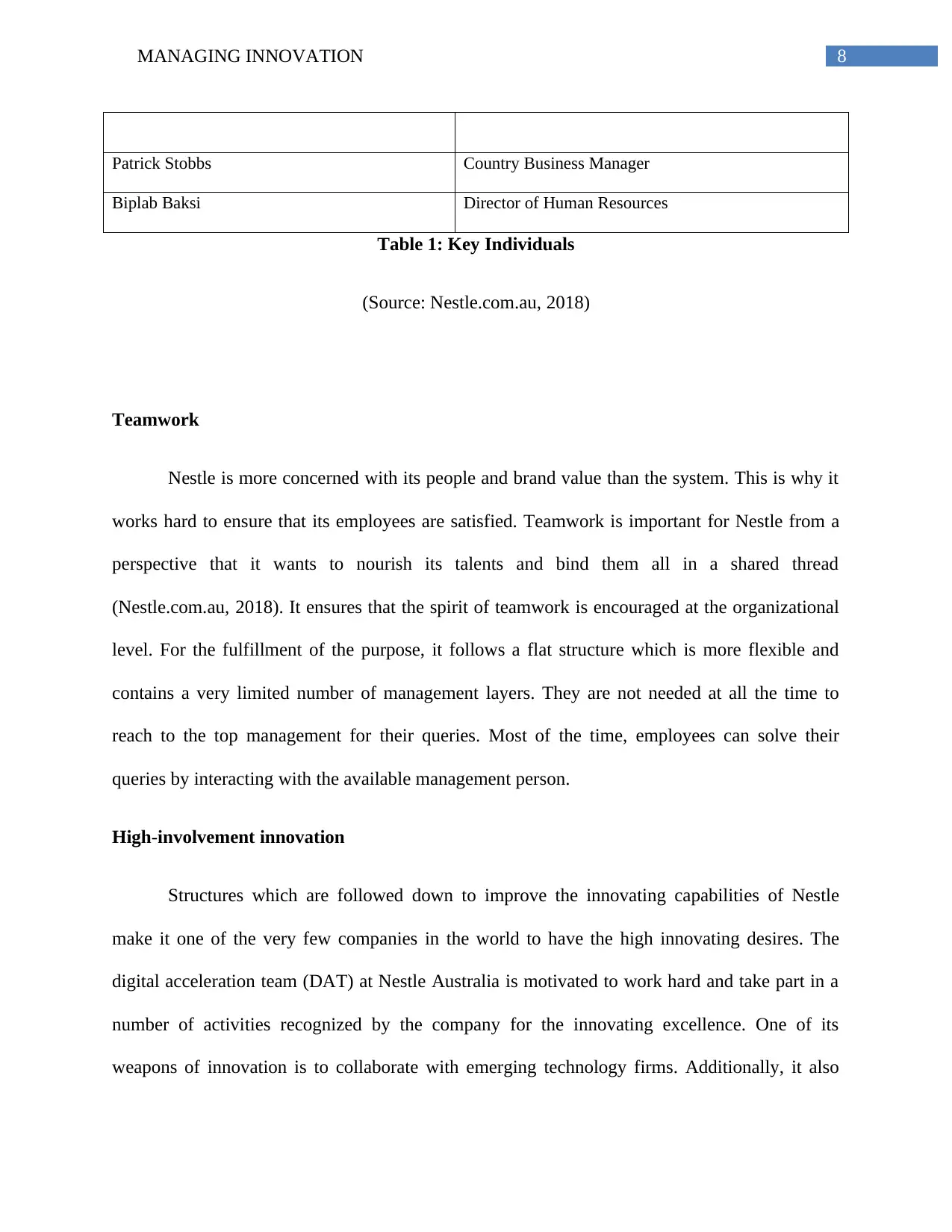
8MANAGING INNOVATION
Patrick Stobbs Country Business Manager
Biplab Baksi Director of Human Resources
Table 1: Key Individuals
(Source: Nestle.com.au, 2018)
Teamwork
Nestle is more concerned with its people and brand value than the system. This is why it
works hard to ensure that its employees are satisfied. Teamwork is important for Nestle from a
perspective that it wants to nourish its talents and bind them all in a shared thread
(Nestle.com.au, 2018). It ensures that the spirit of teamwork is encouraged at the organizational
level. For the fulfillment of the purpose, it follows a flat structure which is more flexible and
contains a very limited number of management layers. They are not needed at all the time to
reach to the top management for their queries. Most of the time, employees can solve their
queries by interacting with the available management person.
High-involvement innovation
Structures which are followed down to improve the innovating capabilities of Nestle
make it one of the very few companies in the world to have the high innovating desires. The
digital acceleration team (DAT) at Nestle Australia is motivated to work hard and take part in a
number of activities recognized by the company for the innovating excellence. One of its
weapons of innovation is to collaborate with emerging technology firms. Additionally, it also
Patrick Stobbs Country Business Manager
Biplab Baksi Director of Human Resources
Table 1: Key Individuals
(Source: Nestle.com.au, 2018)
Teamwork
Nestle is more concerned with its people and brand value than the system. This is why it
works hard to ensure that its employees are satisfied. Teamwork is important for Nestle from a
perspective that it wants to nourish its talents and bind them all in a shared thread
(Nestle.com.au, 2018). It ensures that the spirit of teamwork is encouraged at the organizational
level. For the fulfillment of the purpose, it follows a flat structure which is more flexible and
contains a very limited number of management layers. They are not needed at all the time to
reach to the top management for their queries. Most of the time, employees can solve their
queries by interacting with the available management person.
High-involvement innovation
Structures which are followed down to improve the innovating capabilities of Nestle
make it one of the very few companies in the world to have the high innovating desires. The
digital acceleration team (DAT) at Nestle Australia is motivated to work hard and take part in a
number of activities recognized by the company for the innovating excellence. One of its
weapons of innovation is to collaborate with emerging technology firms. Additionally, it also
⊘ This is a preview!⊘
Do you want full access?
Subscribe today to unlock all pages.

Trusted by 1+ million students worldwide
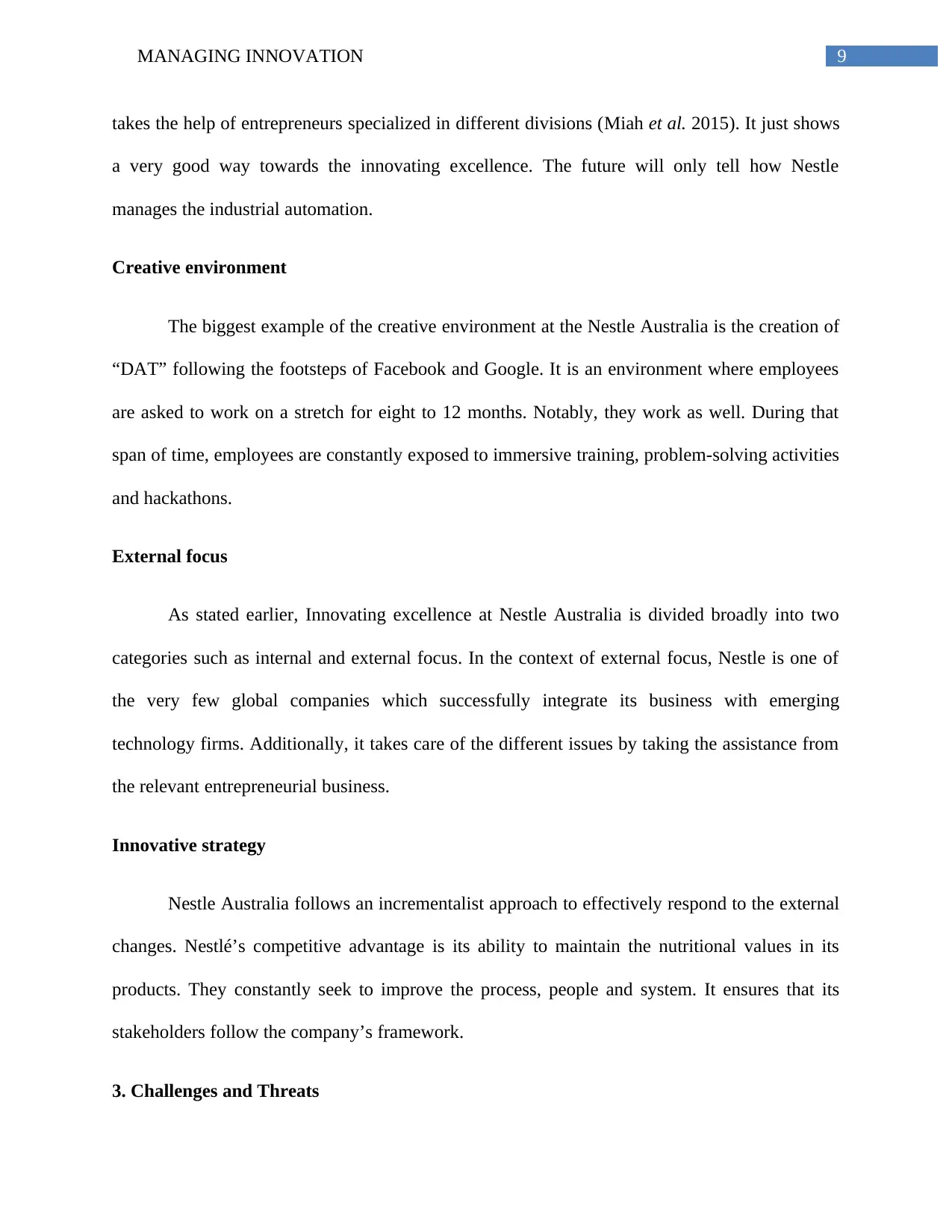
9MANAGING INNOVATION
takes the help of entrepreneurs specialized in different divisions (Miah et al. 2015). It just shows
a very good way towards the innovating excellence. The future will only tell how Nestle
manages the industrial automation.
Creative environment
The biggest example of the creative environment at the Nestle Australia is the creation of
“DAT” following the footsteps of Facebook and Google. It is an environment where employees
are asked to work on a stretch for eight to 12 months. Notably, they work as well. During that
span of time, employees are constantly exposed to immersive training, problem-solving activities
and hackathons.
External focus
As stated earlier, Innovating excellence at Nestle Australia is divided broadly into two
categories such as internal and external focus. In the context of external focus, Nestle is one of
the very few global companies which successfully integrate its business with emerging
technology firms. Additionally, it takes care of the different issues by taking the assistance from
the relevant entrepreneurial business.
Innovative strategy
Nestle Australia follows an incrementalist approach to effectively respond to the external
changes. Nestlé’s competitive advantage is its ability to maintain the nutritional values in its
products. They constantly seek to improve the process, people and system. It ensures that its
stakeholders follow the company’s framework.
3. Challenges and Threats
takes the help of entrepreneurs specialized in different divisions (Miah et al. 2015). It just shows
a very good way towards the innovating excellence. The future will only tell how Nestle
manages the industrial automation.
Creative environment
The biggest example of the creative environment at the Nestle Australia is the creation of
“DAT” following the footsteps of Facebook and Google. It is an environment where employees
are asked to work on a stretch for eight to 12 months. Notably, they work as well. During that
span of time, employees are constantly exposed to immersive training, problem-solving activities
and hackathons.
External focus
As stated earlier, Innovating excellence at Nestle Australia is divided broadly into two
categories such as internal and external focus. In the context of external focus, Nestle is one of
the very few global companies which successfully integrate its business with emerging
technology firms. Additionally, it takes care of the different issues by taking the assistance from
the relevant entrepreneurial business.
Innovative strategy
Nestle Australia follows an incrementalist approach to effectively respond to the external
changes. Nestlé’s competitive advantage is its ability to maintain the nutritional values in its
products. They constantly seek to improve the process, people and system. It ensures that its
stakeholders follow the company’s framework.
3. Challenges and Threats
Paraphrase This Document
Need a fresh take? Get an instant paraphrase of this document with our AI Paraphraser
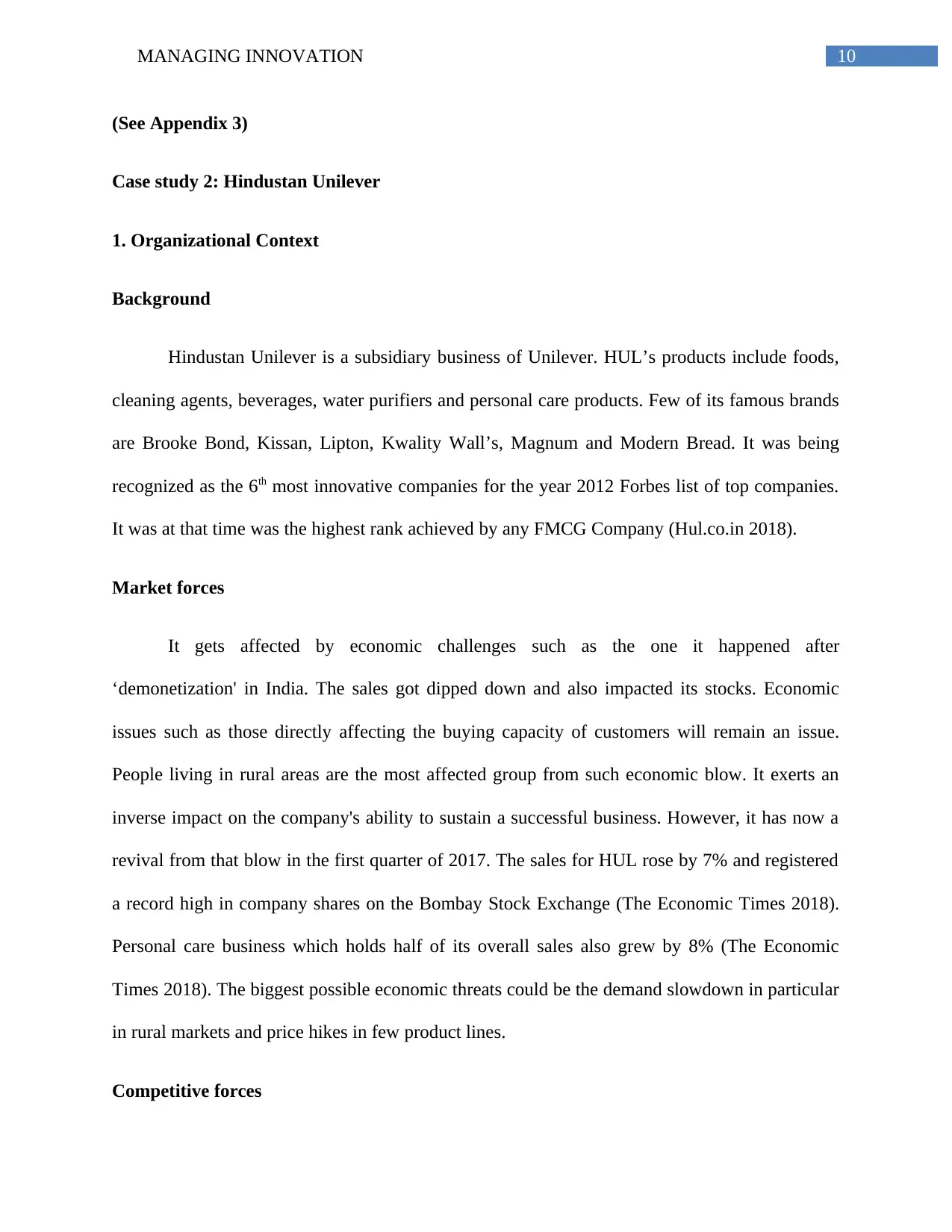
10MANAGING INNOVATION
(See Appendix 3)
Case study 2: Hindustan Unilever
1. Organizational Context
Background
Hindustan Unilever is a subsidiary business of Unilever. HUL’s products include foods,
cleaning agents, beverages, water purifiers and personal care products. Few of its famous brands
are Brooke Bond, Kissan, Lipton, Kwality Wall’s, Magnum and Modern Bread. It was being
recognized as the 6th most innovative companies for the year 2012 Forbes list of top companies.
It was at that time was the highest rank achieved by any FMCG Company (Hul.co.in 2018).
Market forces
It gets affected by economic challenges such as the one it happened after
‘demonetization' in India. The sales got dipped down and also impacted its stocks. Economic
issues such as those directly affecting the buying capacity of customers will remain an issue.
People living in rural areas are the most affected group from such economic blow. It exerts an
inverse impact on the company's ability to sustain a successful business. However, it has now a
revival from that blow in the first quarter of 2017. The sales for HUL rose by 7% and registered
a record high in company shares on the Bombay Stock Exchange (The Economic Times 2018).
Personal care business which holds half of its overall sales also grew by 8% (The Economic
Times 2018). The biggest possible economic threats could be the demand slowdown in particular
in rural markets and price hikes in few product lines.
Competitive forces
(See Appendix 3)
Case study 2: Hindustan Unilever
1. Organizational Context
Background
Hindustan Unilever is a subsidiary business of Unilever. HUL’s products include foods,
cleaning agents, beverages, water purifiers and personal care products. Few of its famous brands
are Brooke Bond, Kissan, Lipton, Kwality Wall’s, Magnum and Modern Bread. It was being
recognized as the 6th most innovative companies for the year 2012 Forbes list of top companies.
It was at that time was the highest rank achieved by any FMCG Company (Hul.co.in 2018).
Market forces
It gets affected by economic challenges such as the one it happened after
‘demonetization' in India. The sales got dipped down and also impacted its stocks. Economic
issues such as those directly affecting the buying capacity of customers will remain an issue.
People living in rural areas are the most affected group from such economic blow. It exerts an
inverse impact on the company's ability to sustain a successful business. However, it has now a
revival from that blow in the first quarter of 2017. The sales for HUL rose by 7% and registered
a record high in company shares on the Bombay Stock Exchange (The Economic Times 2018).
Personal care business which holds half of its overall sales also grew by 8% (The Economic
Times 2018). The biggest possible economic threats could be the demand slowdown in particular
in rural markets and price hikes in few product lines.
Competitive forces
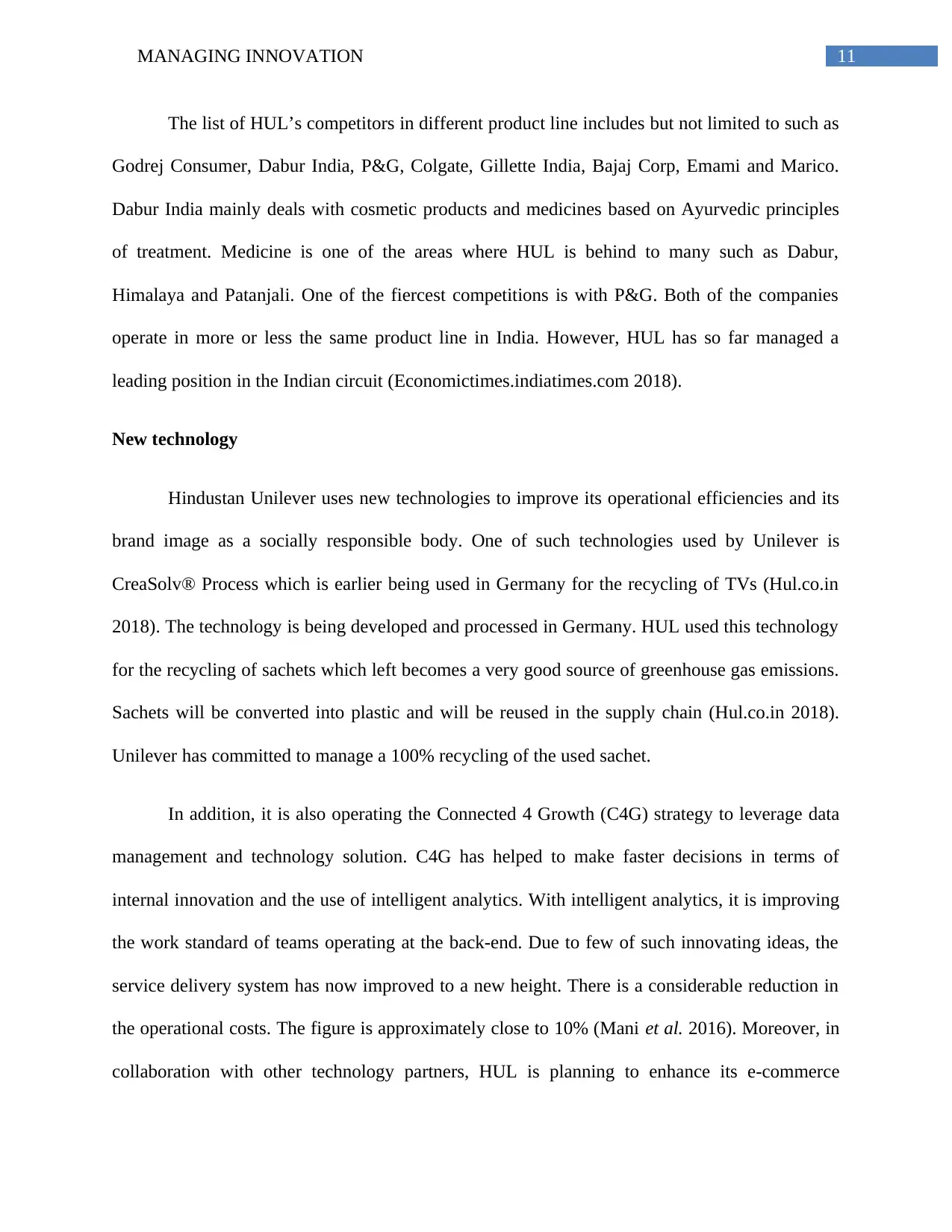
11MANAGING INNOVATION
The list of HUL’s competitors in different product line includes but not limited to such as
Godrej Consumer, Dabur India, P&G, Colgate, Gillette India, Bajaj Corp, Emami and Marico.
Dabur India mainly deals with cosmetic products and medicines based on Ayurvedic principles
of treatment. Medicine is one of the areas where HUL is behind to many such as Dabur,
Himalaya and Patanjali. One of the fiercest competitions is with P&G. Both of the companies
operate in more or less the same product line in India. However, HUL has so far managed a
leading position in the Indian circuit (Economictimes.indiatimes.com 2018).
New technology
Hindustan Unilever uses new technologies to improve its operational efficiencies and its
brand image as a socially responsible body. One of such technologies used by Unilever is
CreaSolv® Process which is earlier being used in Germany for the recycling of TVs (Hul.co.in
2018). The technology is being developed and processed in Germany. HUL used this technology
for the recycling of sachets which left becomes a very good source of greenhouse gas emissions.
Sachets will be converted into plastic and will be reused in the supply chain (Hul.co.in 2018).
Unilever has committed to manage a 100% recycling of the used sachet.
In addition, it is also operating the Connected 4 Growth (C4G) strategy to leverage data
management and technology solution. C4G has helped to make faster decisions in terms of
internal innovation and the use of intelligent analytics. With intelligent analytics, it is improving
the work standard of teams operating at the back-end. Due to few of such innovating ideas, the
service delivery system has now improved to a new height. There is a considerable reduction in
the operational costs. The figure is approximately close to 10% (Mani et al. 2016). Moreover, in
collaboration with other technology partners, HUL is planning to enhance its e-commerce
The list of HUL’s competitors in different product line includes but not limited to such as
Godrej Consumer, Dabur India, P&G, Colgate, Gillette India, Bajaj Corp, Emami and Marico.
Dabur India mainly deals with cosmetic products and medicines based on Ayurvedic principles
of treatment. Medicine is one of the areas where HUL is behind to many such as Dabur,
Himalaya and Patanjali. One of the fiercest competitions is with P&G. Both of the companies
operate in more or less the same product line in India. However, HUL has so far managed a
leading position in the Indian circuit (Economictimes.indiatimes.com 2018).
New technology
Hindustan Unilever uses new technologies to improve its operational efficiencies and its
brand image as a socially responsible body. One of such technologies used by Unilever is
CreaSolv® Process which is earlier being used in Germany for the recycling of TVs (Hul.co.in
2018). The technology is being developed and processed in Germany. HUL used this technology
for the recycling of sachets which left becomes a very good source of greenhouse gas emissions.
Sachets will be converted into plastic and will be reused in the supply chain (Hul.co.in 2018).
Unilever has committed to manage a 100% recycling of the used sachet.
In addition, it is also operating the Connected 4 Growth (C4G) strategy to leverage data
management and technology solution. C4G has helped to make faster decisions in terms of
internal innovation and the use of intelligent analytics. With intelligent analytics, it is improving
the work standard of teams operating at the back-end. Due to few of such innovating ideas, the
service delivery system has now improved to a new height. There is a considerable reduction in
the operational costs. The figure is approximately close to 10% (Mani et al. 2016). Moreover, in
collaboration with other technology partners, HUL is planning to enhance its e-commerce
⊘ This is a preview!⊘
Do you want full access?
Subscribe today to unlock all pages.

Trusted by 1+ million students worldwide
1 out of 30
Your All-in-One AI-Powered Toolkit for Academic Success.
+13062052269
info@desklib.com
Available 24*7 on WhatsApp / Email
![[object Object]](/_next/static/media/star-bottom.7253800d.svg)
Unlock your academic potential
Copyright © 2020–2025 A2Z Services. All Rights Reserved. Developed and managed by ZUCOL.
